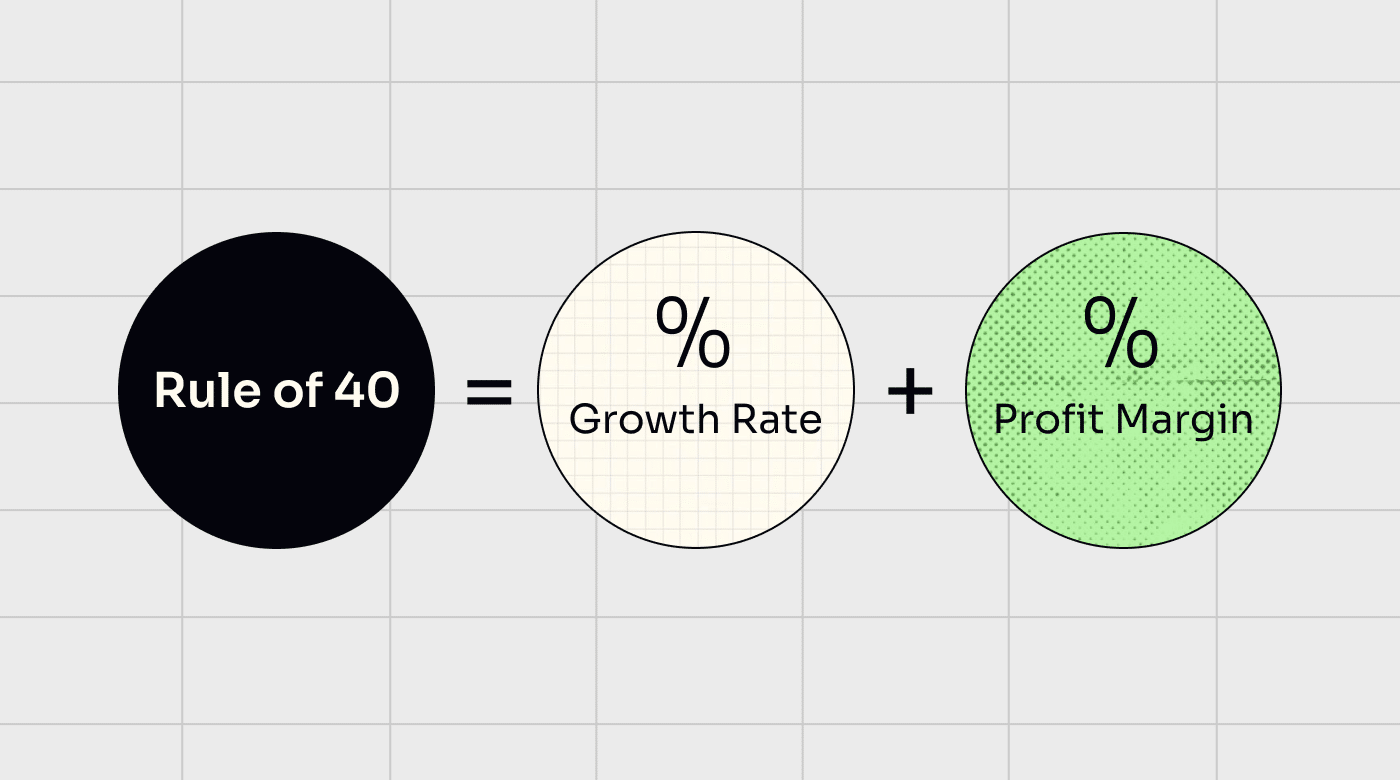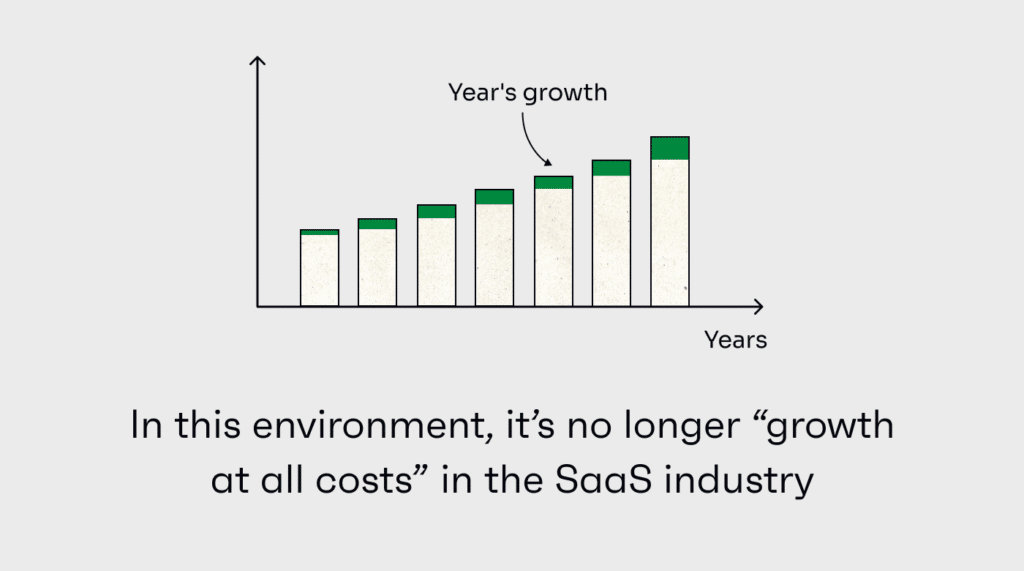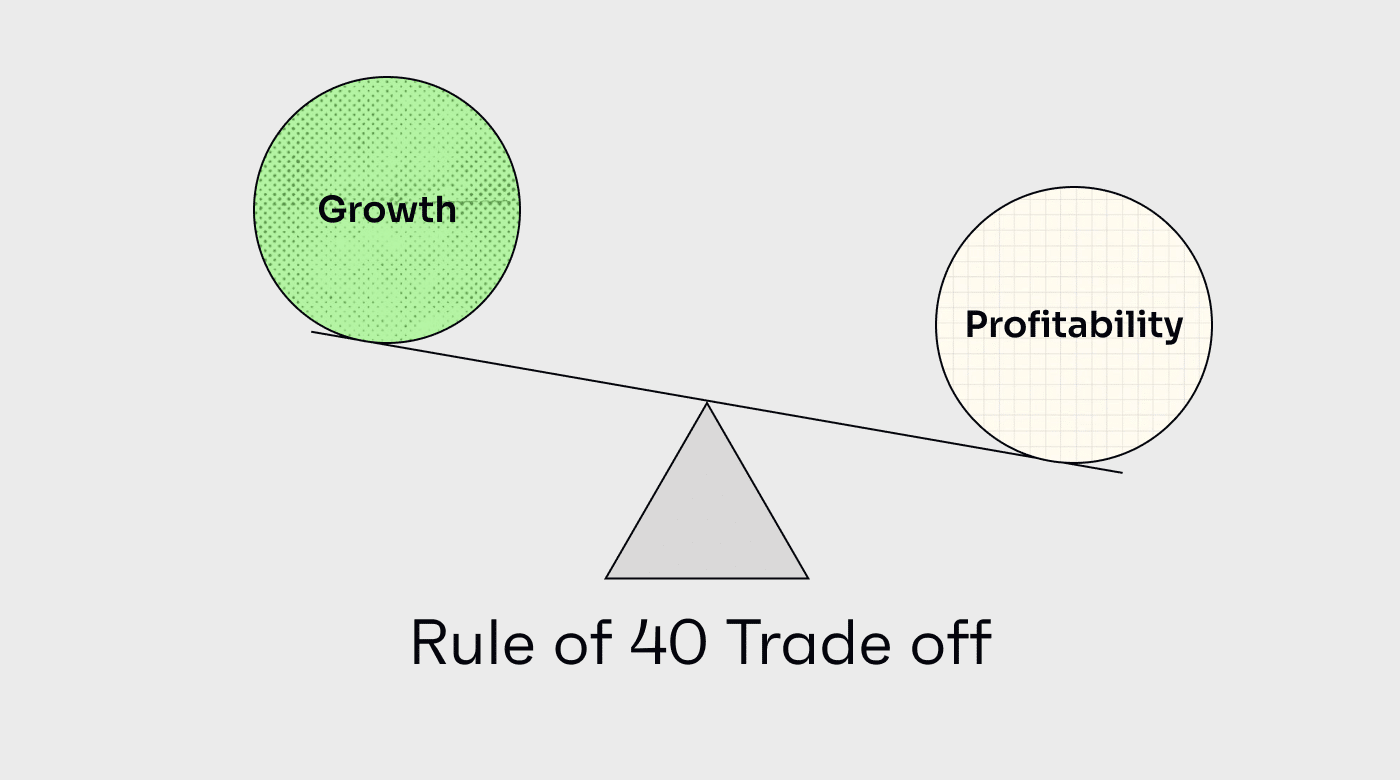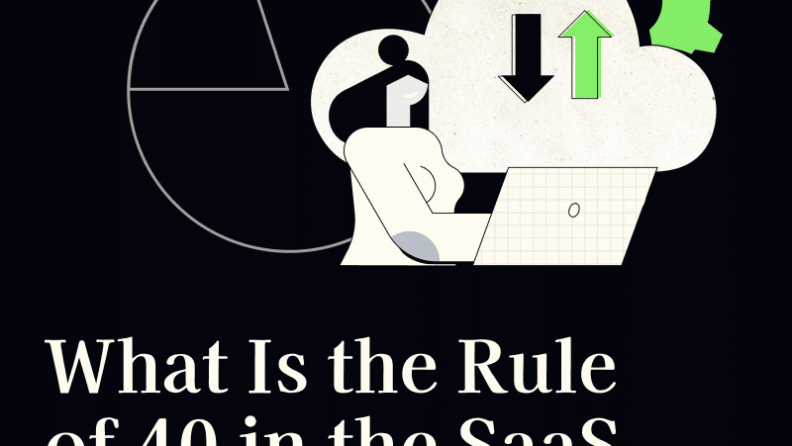Software as a Service (SaaS) companies have revolutionized how firms manage workflows, touching everything from marketing and customer experience to data management and financial forecasting. But in an industry that has long chased explosive growth over everything else (read: profits), how is the performance of SaaS firms even measured?
One popular metric is the so-called Rule of 40. But what is the Rule of 40, exactly—and is it a good metric for financial performance in the SaaS industry?
What is the Rule of 40?
The Rule of 40 is a financial performance metric used by investors and management teams to evaluate the performance of companies—specifically SaaS companies.
The Rule of 40 was popularized by Brad Feld and has since become a standard metric that SaaS investors look to.
The Rule of 40 states that to appeal to investors, your firm’s annual growth rate plus profit margin should be equal to or greater than 40%.
For instance, a company with an annual growth rate of 24% and a profit margin of 19% would pass the so-called Rule of 40 (with a combined total of 43%). This may be an example of a company that’s struck an appropriate balance between growth and profitability.
Likewise, a company with a low profit margin of only 6% but a high annual growth rate of 35% (totaling 41% combined) would also pass the Rule of 40, as investors would be attracted to the high growth—and willing to overlook a low profit margin, at least for a period of time.
The Rule of 40 is specific to the SaaS industry and is typically not applied elsewhere.
This rule is often used by investors to evaluate individual SaaS companies’ financial health or to compare companies against one another. This comparison aspect is quite helpful, as it allows for a balanced comparison between companies that may be at very different stages in the growth cycle.
While the Rule of 40 is a popular metric to aim for, it’s often not reached by tech firms. A McKinsey analysis of more than 200 SaaS firms found that only 16% “passed” the Rule of 40 consistently.
How is the Rule of 40 Calculated?
I've put together a comprehensive explanation of the Rule of 40 calculation already, so I'll only touch this section briefly here. The formula is relatively straightforward: growth rate (as a percentage) plus profit margin (as a percentage).

While the formula is quite simple, there are some considerations in how each metric (growth rate and profit margin) is calculated.
Calculating SaaS Growth Rate
In the SaaS industry, revenue is measured in monthly recurring revenue (MRR). Because SaaS firms primarily employ subscription-based pricing, their revenues are relatively predictable—although churn can cause some fluctuations.
ARR (annual recurring revenue) and MRR figures generally use average revenue per account (ARPA) to calculate expected gross recurring revenue. This allows firms employing consumption-based pricing and those with many variable pricing tiers or custom pricing to quickly estimate revenue figures at any given level of subscribers.
A SaaS firm's growth rate is typically measured by comparing year-over-year ARR figures. The calculation is outlined below.
- Monthly recurring revenue (MRR) = # of active accounts X average revenue per account (ARPA)
- Annual recurring revenue (ARR) = MRR x 12
Keep in mind that the Rule of 40 can also be used to compare MRR figures, which may provide a more accurate and timely estimate of current growth when full-year figures are not yet available.
Calculating SaaS Profit Margin
Profit margin = EBITDA / annual revenue
For profit margin, the most common metric is the EBITDA margin. EBITDA stands for earnings before interest, taxes, depreciation, and amortization.
EBITDA margin = EBITDA / annual revenue
Breaking Down Key Drivers of the Rule of 40
The Rule of 40 is unique because it provides a standardized way to evaluate firms based on a combination of their revenue growth rate and their profitability. This is beneficial because it lets investors quickly evaluate and compare firms in very different stages of growth.
Early-stage SaaS firms typically spend heavily on R&D and marketing. In fact, marketing and sales expenses alone often eat up 80% to 120% of a firm’s revenue in the first three years of operations.

I’ve already covered how to calculate growth rate and profit margin above—but let’s now dive deeper into each of these factors and how they might influence a firm’s future (and its potential as an investment opportunity).
Growth Rate
The growth rate is simply how fast a firm is growing - as you may have guessed. From an investment perspective, it focuses on revenue growth numbers—though some management teams may prefer to look at an internal user/account-based growth rate.
Growth is important for all types of businesses, but it’s always been a particular focus in the SaaS industry. For both B2C and B2B SaaS providers, high growth rates have long been seen as the ticket to success—and the key to attracting equity investment.
But it seems that time has passed (at least, for now).

For a long time, SaaS investors rewarded growth over just about everything else.
That thinking has certainly shifted recently, likely due to the higher interest rate environment we find ourselves in.
With cash becoming more expensive, investors are less willing to bet on a moonshot. Instead, lower, more sustainable growth rates are favored.
A firm’s growth targets matter, too. Firms that set targets too high can end up neglecting margins and other key performance drivers. While high growth is of course attractive, it’s simply not sustainable for most firms long-term.
The same McKinsey analysis I mentioned earlier found that only 1.6% of tracked companies were able to sustain revenue growth rates of 30% or higher.
Targets should be adjusted over time, both to adapt to market saturation and to keep in line with broader business goals.
In the early stages, targeting growth rates of 30, 40%, or even higher is reasonable—but as firms grow, a shift towards improving free cash flow is wise.
Profit Margin
Profit margin is often seen as a less crucial metric for SaaS firms and early-stage companies.
This is partly due to the fact that many of them have negative profit margins in the beginning; in some cases, this can be many years of negative margins and a high cash burn rate.
As companies chase market share, they’re often willing to set aside profitability. Investors have largely been on board with this, pushing valuations for unprofitable companies sky-high.
But again, this is starting to change as investors get pickier and more conservative with their cash.
More mature companies also tend to shift focus to improving profitability as their market becomes more saturated. Firms may achieve this by increasing prices, reducing customer acquisition costs, shifting from subscription-based to usage-based pricing models, and cutting workforce headcount to reduce expenditures.
As firms mature, retention is vital to maintaining margins. In fact, top performers in the McKinsey analysis dedicated significant resources to engaging with and marketing to their existing customers. Many had net revenue retention rates exceeding 100%—meaning they could sustain revenue growth without adding a single new customer.
The Rule of 40 for SaaS Executives & Finance Teams
For SaaS executives, the Rule of 40 is more about managing trade-offs, monitoring their companies’ vitals, and hopefully attracting investors along the way.

All firms must ultimately balance profit with growth—but it’s a particularly fine balance for SaaS firms.
Managers and finance teams face tough trade-offs and, with the higher cost of borrowing and volatile equity markets, funding isn’t as free-flowing as it once was. During equity rounds, financial leaders must do whatever they can to showcase the true business and woo investors—which means having attractive growth and profitability rates is important these days.
Many firms find that as profitability increases, growth is likely to slow, and vice versa.
So, firms and finance leaders must make hard decisions about top-level strategy as well as day-to-day operations. Digging into business intelligence data via CPM software and ERP systems can help teams make more informed decisions.
Extracting lessons from past data, both internal and external, is often key to optimizing performance. Take marketing spend, for example. High-growth firms may spend upwards of 50% of revenue on sales and marketing. If that spend isn’t optimized, it can drag down performance.
Top SaaS firms have optimized sales and marketing spend by:
- Allocating resources based on future customer opportunity (rather than current revenue drivers).
- Centralizing operating data from all across the business to enable managers (and algorithms) to identify relationships between sales tactics, customer data, and growth outcomes (for instance, by comparing customer success data to upsell/cross-sell statistics).
- Utilizing machine learning and analytics to proactively gauge and track customer health, success, and satisfaction, to better enable internal marketing, cross-selling, and retention strategies.
- Expanding into new market segments as opportunities arise—and prioritizing projects with the greatest growth opportunities.
It’s not just sales and marketing, of course. Firms can learn essential lessons by examining data from their own operations and from competitors—across departments, market segments, and growth stages.
While the Rule of 40 is by no means a perfect metric, it can be a helpful quick back-of-the-envelope calculation and a general rule of thumb for SaaS executives when considering changes to their business model or implementing a new pricing strategy, for example.
Ultimately, the Rule of 40 is just one of many important metrics and KPIs that a SaaS finance team should evaluate regularly.
Criticisms of the Rule of 40
Like any other evaluation metric, the Rule of 40 isn't perfect. Let’s discuss a few of its biggest drawbacks and most common criticisms.
Negative Profit Margins Can Still Pass
In the SaaS industry, running a deficit is not uncommon, and many firms don’t reach profitability for many years. That’s why growth is added to the equation in the first place.
With that said, firms with high enough growth rates can still “pass” the Rule of 40, despite deeply negative profit margins. As my old accounting professor used to say, scaling a loss is going to result in an even bigger loss.
Plus, given that the Rule of 40 is calculated based on (relatively generous) EBITDA, it’s easy to see that deeply unprofitable companies are simply not sustainable in the long run—though they can still pass the Rule of 40 with flying colors, in many cases.
Accounting Policy Nuances
Both the growth and profit drivers are too easily influenced by accounting policies and management estimates, affecting Rule of 40 calculations. For instance, companies that capitalize on their R&D will have much higher EBITDA than competitors that expense those costs.
Not a Silver Bullet
Ultimately, SaaS teams have a whole lot on their plates—but first and foremost, every SaaS firm should be providing a top-notch service that customers can’t do without.
The tunnel vision you can get when chasing one particular metric, like the Rule of 40, might mean you're not looking at the whole picture.
Better for Investors than Operators
The Rule of 40 tracks revenue growth and profit margins: arguably the two most important metrics for just about any business.
As such, optimizing for the Rule of 40 is really just optimizing business operations in general.
Anything execs could do to increase profit margins or identify new opportunities for growth in their quest to hit that elusive figure, they're likely already doing it—or they should be.
This is why I see the Rule of 40 as a more helpful metric for investors than it is for executives.
Bottom Line
Sure, hitting that magic 40% feels great.
But instead of straining and contorting your organization (or your accounting policies) to get there, the best thing SaaS execs can do is focus effort on their product, customers, and employees. Growth and profitability will naturally follow.
Looking to build your skills, network, and excel in your field? Subscribe to our newsletter for the latest tech news and insights from industry leaders.


